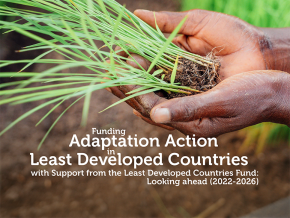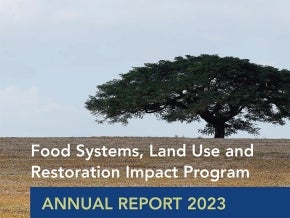New UN-backed Resource Centre launches ahead of COP 26 to build business case for natural solutions to infrastructure challenges.
Governments and investors could save $248 billion a year, protect the environment, and benefit local communities by replacing or complementing newly built infrastructure with plants, trees, and other natural alternatives, according to a first-of-its-kind study from the International Institute for Sustainable Development (IISD).
Richard Florizone, President and CEO of IISD, said, “Sometimes the best solutions are hidden in plain sight. Built infrastructure is responsible for over 60% of global emissions and is driving species and habitat loss. And it’s not always the best tool for the job. Actions like using reefs or mangroves instead of concrete sea wall defenses, or complementing waste treatment plants with reeds or wetlands can be more effective - for both the environment and the economy. Natural infrastructure is a clear win–win for investors and governments looking for solutions as they prepare for the COP 26 climate summit.”
IISD’s research found:
- Nature-based infrastructure (NBI) costs around 50% less than equivalent built infrastructure while delivering the same - or better - outcomes. As well as the lower initial costs, NBI tends to be cheaper to maintain and more resilient to climate change.
- A total of $4.290 trillion worth of infrastructure is needed worldwide each year, and 11% of this could be met with NBI. This results in potential savings of $248 billion a year, roughly equivalent to the GDP of Portugal or New Zealand. By contrast, ending global hunger is estimated to cost an additional $33 billion a year between now and 2030.
- In addition to the cost savings, NBI also generates on average 28% more added value than built infrastructure. This is because it can bring environmental benefits like reducing air pollution or capturing and storing carbon dioxide from the atmosphere; social benefits like providing pleasant spaces to relax; or economic benefits like boosting tourism.
- NBI can bring savings and benefits across all infrastructure sectors, including:
- Around 50% of climate-resilience infrastructure needs can be met with NBI such as plants and mangroves, which can help tackle erosion and flood risks.
- Around 10% of transport infrastructure needs can be met with NBI like swales and wetlands, which retain and slow down water, thus reducing flood damage to roads and railways.
The research marks the launch of the new Nature-Based Infrastructure Global Resource Centre, an innovative collaboration between IISD, the United Nations Industrial Development Organization (UNIDO), the MAVA Foundation, and the Special Climate Change Fund (SCCF), which is managed by the Global Environment Facility (GEF). The Centre will carry out free cost–benefit analyses of natural and built infrastructure projects on behalf of governments and infrastructure developers, and bring together data, case studies, and innovative modelling from projects around the world in a new online hub.
“Nature-based infrastructure makes eminent sense as an investment choice and long-term planning strategy as cities and countries look to build back better from the pandemic,” said Carlos Manuel Rodriguez, CEO and Chairperson of the GEF. “Coming from Costa Rica, a country that invested in nature-based solutions, I see great promise in nature-based solutions that can address climate change while also generating ecosystem benefits and supporting livelihoods. This is why we are happy to support this new Global Resource Centre with resources from the Special Climate Change Fund, which funds innovative climate adaptation actions. Our hope is that this pioneering initiative will help unlock investments for nature-based infrastructure at the scale that we all need, which can help fill the existing finance gap in climate adaptation.”
Li Yong, Director General of UNIDO, said, “The establishment of the Nature-Based Infrastructure Global Resource Centre as a one-stop-shop will be very timely, since it compares financial and economic benefits of nature-based infrastructure with conventional grey infrastructure.”
André Hoffmann, President of the MAVA Foundation, said, “Nature is a generous yet complex system that yields key benefits for society and the economy. Provisions by nature are not only more sustainable but often also cheaper and more stable in the long term than those coming from human-engineered solutions. We must learn to work more and better with nature, and for that we need solid evidence. This is why we are proud to support the NBI Centre so we can make sure that decision-makers have the best knowledge to fully value nature’s contribution.”
About the Nature-Based Infrastructure Global Resource Centre: The Centre aims to bring together key partners to establish a business case for nature-based infrastructure. The Centre provides data, training, and sector-specific valuations based on the latest innovations in systems thinking and financial modelling. For more information visit https://nbi.iisd.org/
About the Special Climate Change Fund: One of the world’s first climate adaptation finance vehicles, the GEF-managed SCCF has two decades of experience working to bolster developing countries’ defenses against a changing climate, with a focus on innovative solutions that can be scaled for broad impact. SCCF-supported projects have reduced the vulnerability of 7 million people and helped bring nearly 4 million hectares of land under more sustainable management to date. As it marks its 20th year, the SCCF is stepping up its focus on attracting private sector engagement in climate adaptation and providing flexible, tailored support for innovations that can help developing countries address their climate risks.


